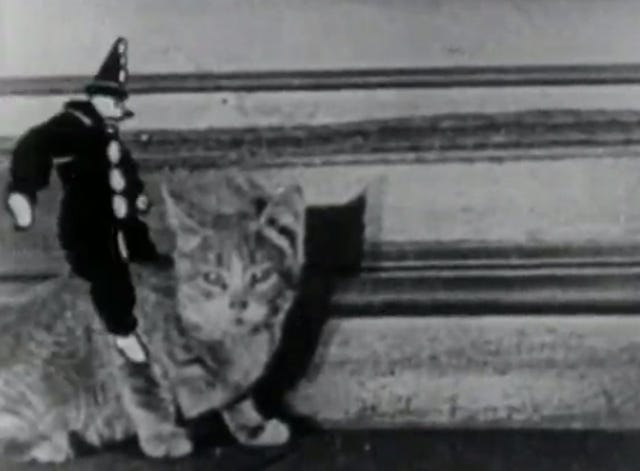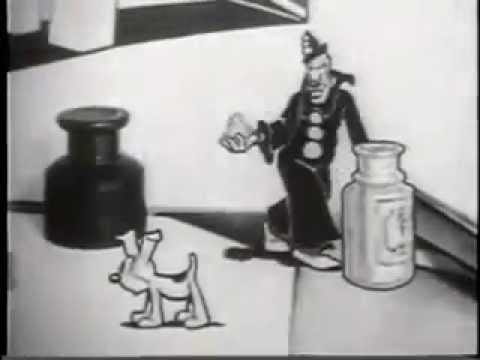The Out of the Inkwell Cartoons Ranked

The OUT OF THE INKWELL cartoon series (also known as INKWELL IMPS for a short time at the end of its life) was produced by the Fleischer Studios from 1918 to 1929. Max Fleischer, animator extraordinaire, was experimenting with his Rotoscope invention as early as 1914. His time at the Bray Studio gave him the chops he needed to go all in with experiments involving a clown character modeled on his brother Dave; this character would become Koko (or Ko-Ko), and Dave would become the chief partner in the enterprise. The Fleischers made these cartoons for Bray until 1921, when they spun out on their own. In 1927, the Fleischers went to Paramount and the series was renamed INKWELL IMPS. Eventually, the series was phased out for the Fleischers’ new flagship series, TALKARTOONS, which introduced Betty Boop and featured cameos of Koko from time to time. I’ve gone into more detail with a whole piece on one particular short, THE TANTALIZING FLY, one of my favorite films of 1919; read about it here. But suffice to say, the Fleischer Studios were putting out the best animation of the 1920s, succeeding Winsor McCay as the greatest animated force in the industry. The cartoon worlds of OUT OF THE INKWELL are the highlight, but the series’ novel concept of having the animated characters interact with the real world was an important facet. Eventually, it became less important, just as it was less important for the rest of the animated portion of the film industry. And ultimately, there are 43 existing and accessible OUT OF THE INKWELL shorts to easily view on YouTube and elsewhere, which I’ve ranked below.
Note: Dave Fleischer is the credited director on every short, even though his role was more so that of a producer. Max Fleischer was the primary creative force and animator, even when the team broadened out with the brothers’ own studio.
#43 — THE CHINAMAN (1920)

This racist caricature-based short (of which there are a few in the OUT OF THE INKWELL series) is also a rough installment from the early days. So I guess I’m saying the racism isn’t even as well-animated?
#42 — THE CLOWN’S LITTLE BROTHER (1920)

Years before he had a dedicated sidekick in Fritz the dog, Koko (still the unnamed clown) had a more cartoon-y little brother in this short. Koko had three distinct eras of design, and already this soon after his debut, he’s morphing from something a bit more flat into a more definable cartoon caricature.
#41 — A CLOWN’S PUPS (1919)

This incredibly short early experiment is amusing, if mostly because of the little dogs. Oh, and Max Fleischer censoring the unclothed clown with his own hand.
#40 — KO-KO’S HAREM SCAREM (1929)

This late OUT OF THE INKWELL short showcases the final form of Koko, but as do better cartoons better ranked on this list. The racist exoticism and blackface caricatures are no bueno, but the cartoon is also preceded by too much strange live action exposition; it left the Fleischer studio for one of few times.
#39 — THE TANTALIZING FLY (1919)

THE TANTALIZING FLY is the short that sells the promise of OUT OF THE INKWELL. It has outstanding character animation reminiscent of McCay, novel interaction between the animated world and real-world objects, and a representation of a cartoon world nevertheless not entirely reliant on the hand of the artist.
#38 — THE CIRCUS (1920)

Koko hangs out with a horse, rendered in more typical cartoon fashion, as was the case for Koko’s compatriots up until the mid-20s redesign. But THE CIRCUS is notable for the horse’s visit to horse heaven, a further extrapolation of the idea that the cartoon world operates on its own terms. Most famously until Felix the Cat, most cartoon series were presented as the renderings of an artist. Of course, OUT OF THE INKWELL retains this concept, but as it went on, Max Fleischer’s hand had less and less to do with the characters, settings, and situations Koko ran into.
#37 — KOKO BACK TRACKS (1927)

Fritz the dog is in full effect as Koko’s sidekick and the clown himself has been transformed, by now, into the more striking cartoon design of the late ’20s. The Fleischer studio’s relative detail in character design, animation, and environments are clear at this point, but BACK TRACKS is a little bit more simple and unamusing than its contemporary installments.
#36 — KO-KO EXPLORES (1927)

This foray into the Middle East and Africa calls to mind the problematic elements of HAREM SCAREM; however, KOKO EXPLORES pulls ahead with a preceding portion with incredible background illustrations and a diverse array of them. Oh, and there’s a severed head.
#35 — KO-KO’S COURTSHIP (1928)

I always love when Koko interacts with a much more “realistic” or McCay-esque woman character, and COURTSHIP is a prime example of it.
#34 — KOKO TRAINS ’EM (1925)

Koko interacts with a little predecessor of Fritz and puts on an act in front of a circus crowd.
#33 — INVISIBLE INK (1921)

Retaining much more of the fourth wall interaction that defined the early days of OUT OF THE INKWELL, INVISIBLE INK features a phenomenal final sequence involving a bunch of Koko doppelgangers.
#32 — THE FORTUNE TELLER (1923)

THE FORTUNE TELLER is a great example of the intermediary design of Koko, when he went from the uncanny valley rotoscoped resident reminiscent of Dave Fleischer (haha alliteration) to a more “typical” cartoon character of the late ’20s and early ‘30s. Of course, this was before the “typical” cartoon character design was defined, and the Fleischer studio helped define it. Koko is also subject to a fun transformation sequence with a deck of magical cards.
#31 — KO-KO’S HYPNOTISM (1929)

Speaking of transformations, Koko and Fritz are compelled into various forms by way of hypnotism, and visit a witch to get back at their tormentor.
#30 — BIG CHIEF KOKO (1925)

Featuring the Fritz predecessor design, BIG CHIEF KOKO is full of troubling native and western tropes. But it also has a tremendous final sequence on a plateau overlooking a beautifully drawn valley. This is a great example of the series’ further dedication to a committed cartoon world and lush backgrounds.
#29 — THE OUIJA BOARD (1920)

Speaking of racism, a live action, cowardly, minstrel-y black character lowers the esteem for THE OUIJA BOARD considerably. Without that element, the short’s haunted house moment(s) make it.
#28 — VAUDEVILLE (1924)

Koko performs on stage after a double-meta moment where Fleischer draws himself drawing Koko.
#27 — KO-KO’S CATCH (1928)

Koko and Fritz get up to all kinds of mischief in a town with strange marionettes/automatons.
#26 — KOKO NEEDLES THE BOSS (1926)

KOKO NEEDLES THE BOSS has a lot of fun with the fabric (haha get it) of the clown’s reality, and he brings it out into the world and has a run in with a real cat.
#25 — CHEMICAL KO-KO (1929)

CHEMICAL KO-KO was the last OUT OF THE INKWELL short; well, it was known as INKWELL IMPS by that time. But for a last run, it’s a relatively inauspicious one. Like HAREM SCAREM, CHEMICAL KO-KO opens with some un-Fleischer-related live action footage. That’s also what makes it feel a bit inauspicious one; Max Fleischer was as much the face of the series as Koko was. But the rest of the funny animal business of the short is well-animated and fun.
#24 — MODELING (1921)

This was the Fleischers’ most ambitious cartoon to date, with Koko sliding around a frozen lake with a lonely cabin in the background. It gets surreal, a word often later used to describe the Fleischers’ work. But the groundwork was laid ten years before SWING YOU SINNERS! (1930).
#23 — FISHING (1921)

The early OUT OF THE INKWELL shorts often took place against a white void background, with other beings and environments sometimes crossing over into the Fleischer-Koko reality. FISHING is a great example of when this started to expand, when he dives into a fantastical marine world.
#22 — TRAPPED (1923)

Koko’s encounter with an incredibly creepy spider-man (not the proper noun superhero kind) is a highlight of the entire series.
#21 — KO-KO HOPS OFF (1927)

Koko and Fritz go for a flight around the world, with some incredible water and weather effects that were way ahead of their time. Also of note: the depth of the background Paris illustrations.
#20 — KO-KO’S CONQUEST (1929)

CONQUEST has live action practical effects that approximate cartoon effects (a man’s stomach blows up like a balloon from water), eerie close ups, and just a haunting image of a bunch of hung men (from the neck, not…you know). It’s a good ‘un.
#19 — KO-KO THE KNIGHT (1927)

I’m a sucker for medieval imagery, and Koko’s interaction with a tropey villain and damsel offers up a lot of funny gags.
#18 — KO-KO’S KANE (1927)

Koko has fun with a high-tech cane and works on Max’s real-world one. He also spins open a safe with his ass. It’s hilarious.
#17 — TOOT TOOT (1926)

Cartoon train humor is so funny to me because it just totally defies the laws of physics. I mean, cartoons do in general, but there’s something so inherently ridiculous about watching the cars of a train contort and fly around.
#16 — FADEAWAY (1926)

This is an insane short. It’s a far-ranging cartoon with a bunch of locales, ending, as usual, in the real world. FADEAWAY is a great example of the inventiveness of the Fleischer studios. No one was making cartoons like this in 1926.
#15 — CARTOON FACTORY (1924)

Yet another “breaking the fourth wall of the fourth wall” OUT OF THE INKWELL short, Koko gets involved with a machine that does all the work of Max Fleischer for him, including producing Max-toy-soldiers. Wildly inventive, and some of the most striking live action/animation integrations in the entire series comes through with Fleischer’s model careening through the animated world. And that’s saying something for a series known for its live action/animation integration.
#14 — THE MECHANICAL DOLL (1922)

Earlier, I mentioned how much I appreciated when Koko interacted with a female character almost out of bounds with his cartoon simplicity. Nowhere is this more apparent than in THE MECHANICAL DOLL, where the titular female form moves with a grace that, perhaps more than anything other than the earliest Rotoscope experiments, calls to mind the uncanny valley that Winsor McCay was able to produce, and that wouldn’t be matched again until the mid-30s Disney work.
#13 — KOKO THE CONVICT (1926)

I’m not quite sure what it is about KOKO THE CONVICT that I like so much; certainly the jailhouse scenes are well-illustrated and the gags neatly conceived. But maybe I can attribute this short’s high ranking simply to one of the final images of animated guards streaming out of tall buildings, ultimately flooding the skyline with ink that deteriorates to reveal the hand of the artist and an ink-sopped paper. Just a tremendous redirect.
#12 — KO-KO’S HOT INK (1929)

While I’m here, I think I’d just like to reflect on what it is I like about the later OUT OF THE INKWELL shorts: it’s the dark yet sharp outlines. The Fleischers’ characters do truly look like blots of ink, gelatinous and fluid yet solid and realistic. Oh, and yeah, HOT INK has some of the best live action gags in the series, which typically pale in comparison to the all-animated antics.
#11 — KO-KO’S REWARD (1929)

I always love animated haunted house antics, and KO-KO’S REWARD has that in spades, in spite of its lackluster and honestly kind of strange live action sequences. But when Koko and Fritz are running around an underground hellscape, with the live action girl turned into an animated one in the guise of a strange creature; look, it’s a good ‘un.
#10 — BUBBLES (1922)

Koko’s close-ups against the surface of a bubble in the appropriately titled BUBBLES would be the highlights of this cartoon, but then he also bounces around a bubbly landscape and incredibly animated bubbles escape out into the real world. I’m taken with the shimmering orbs the Fleischer studio was able to produce here.
#9 — FALSE ALARM (1923)

I remember thinking FALSE ALARM was a turning point OUT OF THE INKWELL short. Here was a full-fledged world relatively novel for the series, and gags that feel like they came out of a Buster Keaton short. That’s about as high a compliment as I can pay it.
#8 — KO-KO’S HAUNTED HOUSE (1928)

From here on in for this list, my favorite OUT OF THE INKWELL shorts are defined by a sort of macabre, striking fantasy that were elevated in these select shorts. As mentioned, I love animated haunted house antics, and KO-KO’S HAUNTED HOUSE was the strongest of these in the series. The image of Koko and Fritz swirling in the eyes of a stark white skull against a black background is incredible.
#7 — KOKO IN 1999 (1927)

Koko gets chased into the future by Father Time and what he finds there are machines that conveniently inconvenience them. A perfect 1927 complement to METROPOLIS.
#6 — THE CURE (1924)

Koko interacting with a bunch of animals is always a delight, but the highlight of THE CURE is the animation of faces onto real-world objects. Ghastly stuff.
#5 — TRIP TO MARS (1924)

I am incredibly attracted to the futurism of yesteryear; KOKO IN 1999 and TRIP TO MARS, therefore, are two of my favorite OUT OF THE INKWELLs. Apropos of nothing, the short starts with some big-headed Koko shenanigans, then launches into extraterrestrial mania.
#4 — BED TIME (1923)

This could be one of the strangest comparisons I’ve ever made, but Koko flying through the Cave of Winds in BED TIME is like the whirligig of naked bodies in L’INFERNO (1911); totally alien and otherworldly. And the short never loses that energy, bringing Koko into contact with a giant wrestler. As I’ve mentioned a few times, oftentimes Koko interacted with characters who carried a somewhat different kind of artistic sensibility. Whether this was intended or not, it results in the clown feeling like a true stranger in a surrealistic world. That’s part of the power of OUT OF THE INKWELL, to me. It’s also really cool seeing a huge animated figure towering against a real-world panorama of a city skyline, as Koko does in BED TIME.
#3 — KO-KO’S EARTH CONTROL (1928)

Perhaps one of the darkest OUT OF THE INKWELL cartoons, KO-KO’S EARTH CONTROL sees the clown and his dog playing with the very fate of the world. Oh, and yeah, they end up destroying it. Sun and moon engage in surreal combat, lightning crashes, Fritz chops down a threatening tree against a yawning chasm; it’s all very frantic and apocalyptic. What a manic product of a relatively static animation industry that was soon to be shaken up.
#2 — KOKO’S PARADISE (1926)

I know I said EARTH CONTROL is one of the darkest shorts in the series, but KOKO’S PARADISE might take the cake. Koko and Fritz literally go to heaven and hell, realms brought to the screen with incredible atmosphere and backdrops. KOKO’S PARADISE is a prime example of why I love the artistry of animation; it’s one of the most investing cartoons of its era.
#1 — JUMPING BEANS (1922)

I know I said FALSE ALARM felt like a turning point cartoon for OUT OF THE INKWELL, but JUMPING BEANS preceded it, and together, they signaled a new era for the series and cartoons in general. Koko was being redesigned, he was encountering surreal beings in the skies and an army of doppelgangers, and doing it all against unmatched illustrated backgrounds. I know I’ve kept coming back to the backgrounds (nice one, self) for this piece, but the fact of the matter is that many cartoons of the era lacked a visual depth. Characters interfaced in a relative void, which was characterized by simplistic details that didn’t serve to create an animated world the way the Fleischer studio was able to do with OUT OF THE INKWELL. And JUMPING BEANS is the best example of that.
